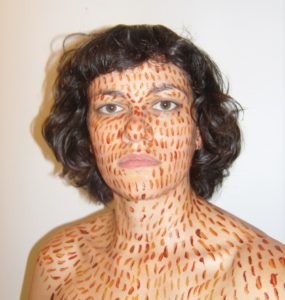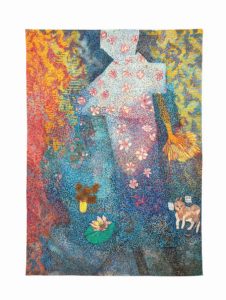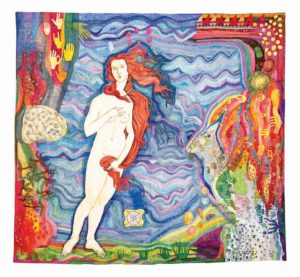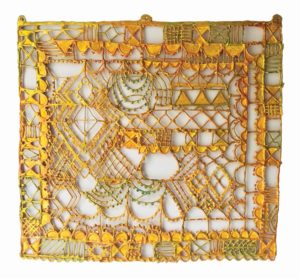To reach Zehra Khan’s zany show at the Provincetown Art Association and Museum, one must walk through Philip Malicoat’s impressive exhibition of somber, formally astute paintings, rendered in a narrow range of carefully calibrated grays. The work of this celebrated Provincetown painter of the last century is a dramatic contrast to Khan’s, which is all about riotous color, mess, and an irreverent engagement with art history. It’s an appropriate juxtaposition for an artist who talks about her work as a “subversion or contrast to ‘real art.’ ”

Khan wants her work to feel unexpected. “Who let this fool in the back door?” is a response she imagines — and hopes for. “Sense of humor is more important than anything else,” she says, and she has no problem playing the fool to get people to engage with her work.
“To make someone think with humor is probably my biggest goal,” says Khan, who in one video dons an oversize rabbit head while hanging laundry in the snow.
The best joke in the show is perhaps her most recent work. While installing the show, Khan became curious about a bust of Charles Hawthorne permanently displayed in the gallery.
“It’s strange to have another person’s artwork in your show,” she says. “I can bring this weird presence over to my side,” she thought. Always prepared with extra finished artwork, Khan took one of her fabric pieces, cut holes in it for the eyes, and slipped it over his head. “Now it’s a ghost,” she says.
“I love site-specific work,” Khan says, likening it to improvised comedy and off-the-cuff jokes. This joke is particularly smart. Hawthorne’s subverted bust slyly raises some serious questions about authorship, institutional authority, and patriarchy.

Hawthorne’s Ghost came together quickly, but most of the other pieces in the show are the result of years of intensive work. She pitched this show to PAAM in 2016 and since then has reworked most of the art, using Sharpies to cover both sides of large bedsheets with small strokes.
In Ecstatic, a semi-figurative work, the marks expand, condense, and overlap in flowing currents of blue, red, and orange. Like the Impressionists, she mixes colors by placing pure pigments next to each other.

“I love watching colors vibrate by putting contrasting colors together,” says Khan. Her use of marks and approach to color recall artists such as Monet, Van Gogh, and Bonnard.
In addition to referencing the visual language of the masters, Khan pulls images from their paintings, a process “born out of a desire to look at classics.” In Ecstatic, she includes a vase of Van Gogh sunflowers and one of Monet’s lilies. And then there’s a cat saying “Meow, meow, meow, meow” in text both backwards and forwards. “I put in some of the classics and then something ridiculous and stupid,” she says. “It’s got to have both.”
Animals show up frequently in her work. A pigeon made from trash perches on a wire in the gallery, inspired by her observations of people feeding pigeons at temples in Nepal, where she did an artist residency.
“Animals are my conduit for speaking about human emotions,” she says. Pairs of rats cavort across one painting, the surface a comforter someone gave her for a camping trip in the dunes. She describes the work, titled Provincetown Rat Blanket, as a commentary on “relationships and excess,” with the rat couples depicting “snapshots of myself in relationships with different people.”

Among the rats is an image of the Pilgrim Monument. She also works with local imagery in Provincetown Venus, a reimagining of Botticelli’s Venus on a king-size sheet, where Venus is surrounded by shells, sea plants, and wavy bands of blue.
Most of the works in the show were started in Provincetown, where Khan lived for 10 years after receiving her M.F.A. in 2009 from Mass Art, which at the time ran a low-residency program in partnership with the Fine Arts Work Center. In addition to reflecting her experience in Provincetown, they also refer to her cultural background as the child of a mother from Idaho and a father from Pakistan.
From the Idaho side of the family came a fascination with the Americana traditions of embroidery, samplers, and quilting — crafts practiced by her mother and grandmother. “I don’t have the patience to do these things,” she says. “I create my own version.”
On display in the show are two paper quilts, pieced together with interlocking hexagons she created from personal papers including elementary school homework and calligraphy exercises.

Furthering her exploration of geometric patterning, Khan creates free-hanging compositions with hot glue. “I’m making fake lace with a lot of repetitive diamonds,” she says, with references to Asian patterns and decorative motifs.
For any good joke, the delivery is crucial. In Khan’s work, the delivery is in the materials. “Usually, I’m anchoring it on a story of a tradition and lampooning a whole craft,” says Khan. There’s an absurdity in interpreting these precious craft traditions with paper and a glue gun or making a labor-intensive Impressionist painting with Sharpies and a king-size sheet. The joke, however, is never at the expense of her audience.
“I’m big into accessibility of materials,” says Kahn. “I love it when kids enjoy my work. I need it to be accessible.”
A sense of generosity pervades Khan’s art. They’re visually rich, unpretentious works that excite viewers. While speaking in the gallery at PAAM, Khan was continually interrupted by visitors expressing their joy and admiration for the work. The strength of this show suggests that perhaps museums should start paying more attention to the back door — a place for the likes of Khan and whole new audiences to enter.
Playing the Fool
The event: An exhibition of works by Zehra Khan
The time: Through Aug. 28. Reception: Friday, July 22 at 6 p.m. Talk with artist and curator Megan Hinton: Thursday, Aug. 4 at 6 p.m.
The place: Provincetown Art Association and Museum, 460 Commercial St, Provincetown
The cost: $15 general admission



